December 19, 2018
With the New Year upon us we are finalizing our 2019 sailing calendar and hope to have it online soon. Again we’ll be offering our two- and four-hour trips along with our popular and special Two-Day Around Drummond trip. We hope to put on the schedule for June sometime a trip to Beaver Island and a cruise up the St Marys River to the Soo Locks. Star Lore Historian Mary Stewart Adams will be presenting stories of the summer nighttime sky during a star gazing trip in July and one in August. July 4th we’re offering a special Fireworks Afloat bed and breakfast. Look for us at the DeTour Riverfest and Les Cheneaux Antique Wooden Boat show in August, and the week between to be offering sailing trips from Hessel. Then in September we’re planning another four or five day cruise up the St Marys River to the Soo Locks.
Trips and weddings are already being booked for next summer, so if you have a special date in mind or any questions, please ask. During the winter we work at home a lot, where we don’t have any phone service, so emailing us at sail@ditallship.com is best. Or you can text Julie at 906-430-5854 or leave a message and the next time we’re in town we’ll return your call. Learn more about Schooner Huron Jewel at www.ditallship.com, follow us on Facebook, Instagram and Pintrest @DITallShip.
This winter we’re also working on writing a book about building Schooner Huron Jewel. Most of the content will be new writings from Capt Hugh and Julie and include many photos not previously posted on our website www.ditallship.com. Capt. Hugh has been writing about the designing of the schooner and so we present you with some insights to what went on before any materials were purchased.
——————————
The designing of Schooner Huron Jewel had input from many sources over the years, as I had thought about it quite a bit. In fact, soon after completing a 36’ sailboat, I started thinking of a larger boat with standing headroom and more and larger berths.
Eighteen or twenty years ago I talked with George Buehler, a boat designer and author from the Seattle area. I ordered some study plans from him for Dragonfly, a 50’ on deck schooner. This boat is typical of his designs – heavily and traditionally planked in wood, hard chines, v-bottom and plenty of sheer to the deck to give lots of salty curves to a pretty boat. Not over-canvassed at all (he turned out in the end to be a trawler guy), but still a nice start, although I don’t care for large double-enders with outboard rudders. All wood, all backyard-built, low tech and no fancy materials were required. We talked about giving her a regular transom and stretching her to 64’ (he included drawings for the extra length). I made a half-model to hang on the wall and contemplate. A seven or eight foot draft, though, is a lot either in the Great Lakes or the Atlantic coast, and especially in the Bahamas. It would be a fun boat to build though, deep and stable, narrow and tall, comfortable and plenty of room for everything.
I had already built my New Haven sharpie, Gypsy Meltdown, 36’ on deck, after modifying a design that the boat designer and builder Reuel Parker had redrawn from lines that the maritime historian Howard Chappelle had collected from old boats. Reuel modernized the old-time construction methods to include plywood and epoxy (lots of epoxy) and simplified curves. Reuel designed and built several sharpie-rigged schooners, basing the hulls on an improved round-bottom sharpie design. These evolved in the late nineteenth century when yachts were starting to be built, that weren’t just workboats designed to carry a heavy load, but meant to be sailed by the owner with only cruising stores on board. These boats are still sailing successfully and provide a benchmark for what will work as far as stability and speed goes.
These boats were more attractive to me for their shallow draft, light weight, and potential for speed. The drawbacks are lack of interior volume and potential for “excess motion” in a seaway, meaning not comfortable enough for a long trip. They carry enough sail to be powerful in light winds and not be slow. They are, of course, obviously not modern production boats, but I wanted even more of the traditional look than they have with their epoxy-everything and simple curves. I ordered study plans for several of his large schooner designs and discussed some of the problems with Reuel involving how to get enough accommodations below in such shallow hulls. In the end, instead of building his Leopard design at 60’, I decided to start from scratch with those boats as proof that a boat of that size and shape and sail area can be successful. I wanted a boat that had shallow draft, for both here and Florida and the Bahamas require a shallow boat. We wanted standing headroom, especially in the galley, and a comfortable two-person berth. The new boat needed to have room for guests, but not be so large she couldn’t be sailed with only two people aboard.
For Schooner Huron Jewel’s plans, I started by scaling up the New Haven Sharpie I’d built to get standing headroom in the cabin. I came up with a scaling factor of 150% to get a design of 54’ on deck and 12’ beam. I rounded the bottom to gain more volume, but it was still a two-person boat – no room for friends, crew, dinghy or more importantly passengers. 55, 56, and 58 feet were still lacking in interior volume without making the boat excessively wide. Although most modern boats have plenty of beam for just this issue, a narrow hull is much easier to power through the water and takes that much less sail or engine power to go somewhere. Shallow draft, as mentioned, was very important, to allow the ability to go close to shore sailing and to be able to anchor in small out-of-the-way coves.
I had come to realize with the sharpie that there are many ways to make a boat stand up to her sail and go through the water. Length, width and draft all play an intertwined part and solving a puzzle with so many variables is a challenge. Expense, crew required, how to haul out in the fall and how to maintain a given engineered structure are all in the mix, too. The physical restraints also change with physical shape. For instance, a common term for sailboats is “hull speed”. This is usually given as 1.34 times the square root of the waterline length in smooth water.
This works pretty well for most normally-shaped vessels because it describes the speed of waves in saltwater in relation to their distance apart. For example, a boat with a 100 foot waterline has a hull speed of 13.4 knots. (Square root of 100 is 10, times 1.34 is 13.4.) A boat moves through the water, displacing it, and forms a bow wave and a stern wave, and at hull speed, the boat is in a deep trough exactly between the two waves and cannot be made to go faster. A narrow boat moves somewhat less water out of its way and can go a little faster than hull speed. A narrow and very shallow boat moves a lot less water and with enough power applied can escape the hull speed limit and just skim the surface (planing) and go a lot faster.
The trick with a sailing vessel is to have enough width and depth to provide enough stability to carry a sufficient amount of sail, which makes the owner proud and the mate happy to be “getting somewhere.” The underwater shape is also very important for stability. A “hard-chine” design has obvious corners at the turn of the bilge and adds tremendously to the stability but can make for an uncomfortable motion at sea. A longer boat is more stable comfortable, and faster.
I considered many line plans from Chappelle and the great schooner designer John Alden, among others. I looked especially at the Alden schooner Mayan, which for a long time belonged to musician David Crosby. I had made the acquaintance of the captain who ran that boat for David and who could judge her strengths and weaknesses. His encouraging words about how she handled allowed me to consider the design as a successful example of a relatively narrow and shallow boat built from wood. A modern boat, the MacGregor 65, is only 12 feet wide and has a very light shallow hull with very limited volume. It provided input from the current era of materials and design, representing the far edge of the envelope of what is possible and what people want to own.
Using some free obsolete design software and many pages of paper, I settled on a length and width (beam). Due to the requirement for shallow draft, a centerboard instead of a full keel was needed to provide the necessary underwater lateral area. Centerboards aren’t about stability, but add underwater area to balance the sail area. A lifting keel is different, and on a boat of some size affects stability somewhat, but in this design some additional area from a centerboard was needed for when we are sailing upwind. The bottom profile remained in flux until the epoxy set on the first structural pieces, changing slightly due to additions and subtractions of weight here and there and re-calculations of longitudinal center of gravity. I drew in the galley and accommodations, different from Beuhler in that the hull is so shallow, and different from Parker because there is more headroom throughout.The hull has some roundness to the bottom – as much as the materials and technique would allow.
Then there is the deck layout – the masts have to go somewhere, and the rigging has to be in the right place, hatches have to be out of the way of moving parts, and a hundred other things. I had set up a long rope on a wall at the house, stretched between a porch post on one end and an elderberry bush on the other to represent the deck line of the full-size schooner. I could measure the height and length and adjust the curve to suit my eye. That rope was up for two or three years, and despite the shaking of visitor’s heads was a great help in determining exact dimensions and shape of the finished boat.
Eventually, when the project got good and started and we bought property and poured concrete, I could set up a three-dimensional full-size model or mock-up with 2’ x 4’s. This mock-up was from the waterline up to the cabin top, and had masts and all. We could walk around in it and discuss proportions and placement of the various interior parts of the boat. Sometimes this meant making the boat a little wider or moving a bulkhead to get more room for a bunk. I would then have to measure carefully and go home and get the eraser out and redraw the plans.
I built a platform aft and a mount for the ship’s wheel to be able to stand there and make sure I could see forward from there and that everything looked right. Anchor windlass, bowsprit, sheet leads, all these things had to be located and measured and transferred to paper, then the estimated weight calculated and center of gravity worked out, which meant moving things like battery banks and then redrawing the plans again.
All boats are compromises, and to be right they have to do what the owner wants and in the way he wants it done. Huron Jewel draws 4 feet 4 inches of water, has standing headroom, sails well with plenty of stability and is a joy to look upon.
– Captain Hugh
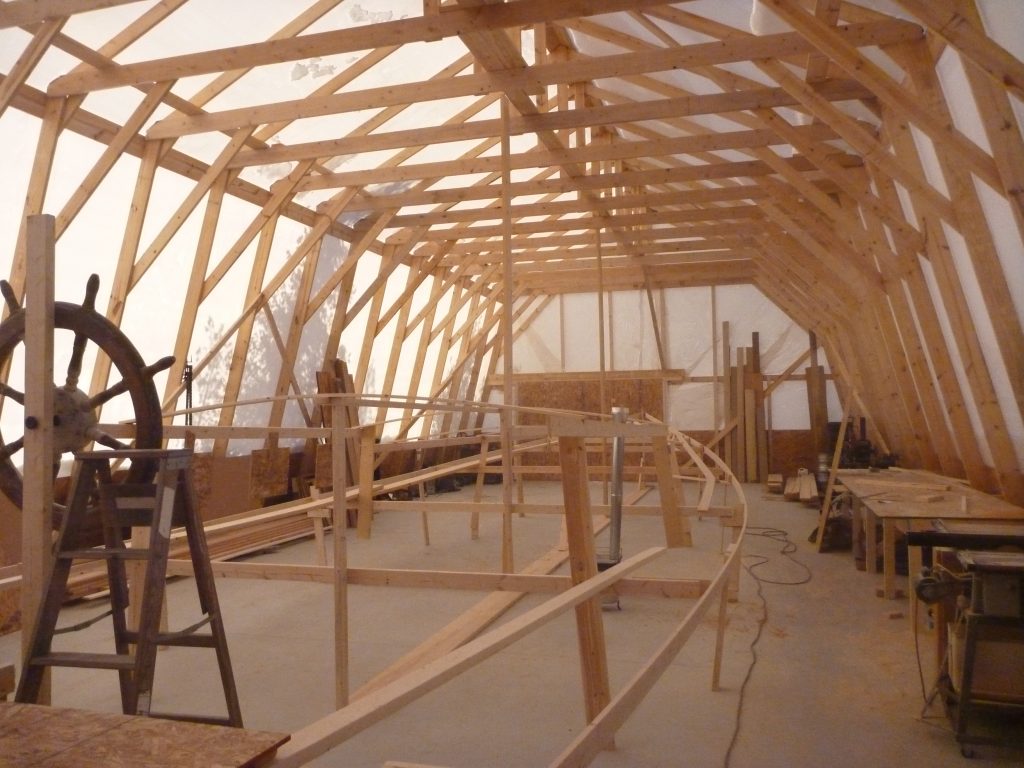
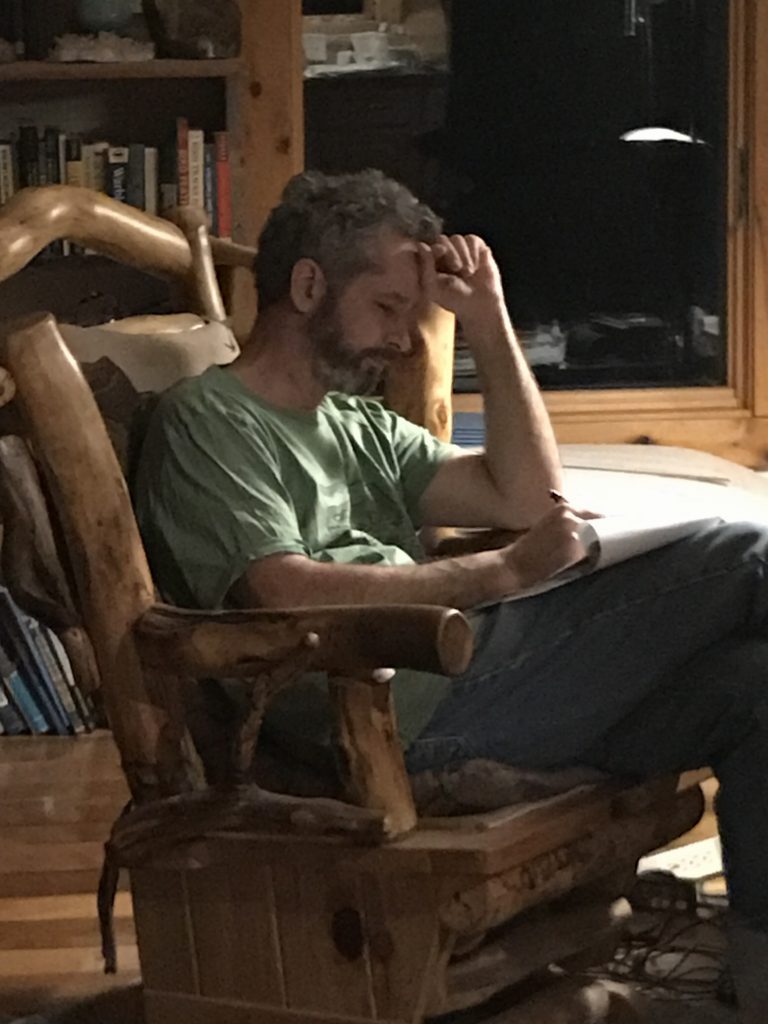
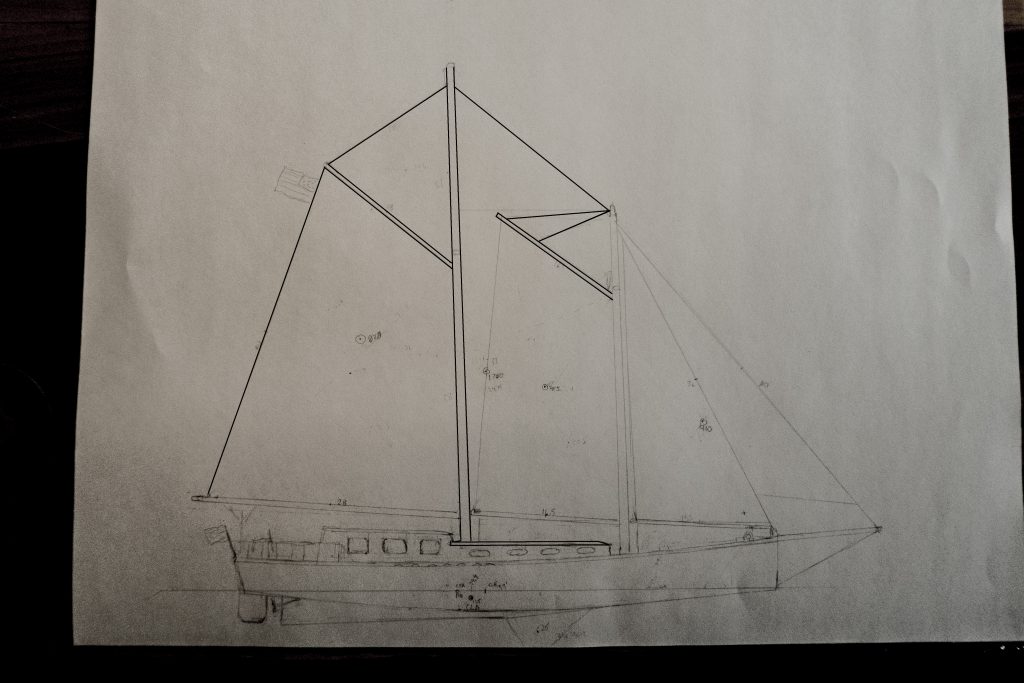



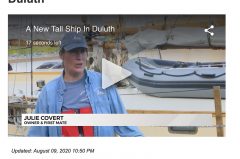
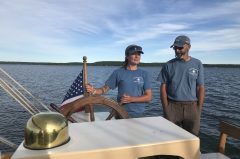
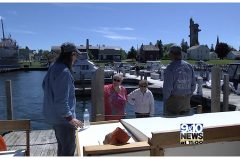


Leave a Reply